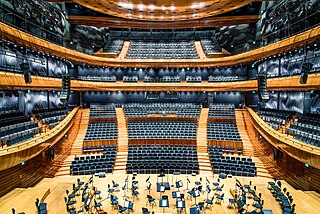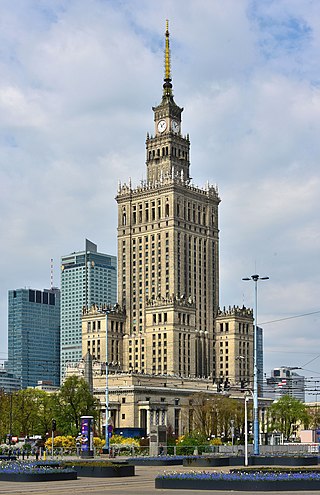
The Palace of Culture and Science is a notable high-rise building in central Warsaw, Poland. With a total height of 237 metres (778 ft), it is the second tallest building in both Warsaw and Poland, the sixth tallest building in the European Union and one of the tallest in Europe. At the time of its completion in 1955, the Palace was the eighth tallest building in the world, retaining the position until 1961; it was also the tallest clock tower in the world until the installation of a clock mechanism on the NTT Docomo Yoyogi Building in Tokyo, Japan.
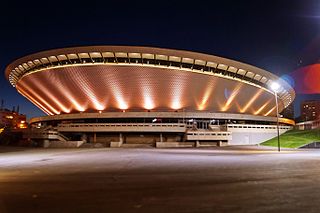
Katowice is the capital city of the Silesian Voivodeship in southern Poland and the central city of the Upper Silesian metropolitan area. It is the 11th most populous city in Poland, while its urban area is the most populous in the country and one of the most populous in the European Union.
The year 1934 in architecture involved some significant architectural events and new buildings.

Stefan Władysław Bryła was a Polish construction engineer and welding pioneer. He designed and built the first welded road bridge in the world.
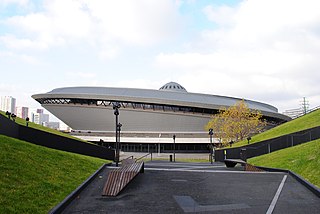
Spodek is a multipurpose arena complex in Katowice, Poland, opened on 9 May 1971. Aside from the main dome, the complex includes a gym, an ice rink, a hotel and three large car parks. It was the largest indoor venue of its kind in Poland until it was surpassed by Tauron Arena in 2014.

On 28 January 2006, the roof of one of the buildings at the Katowice International Fair collapsed in Chorzów / Katowice, Poland.

The Pałac Goldsteinów or Goldstein Palace is neo-renaissance palace, which was built by two brothers, Abraham and Joseph Goldstein. It is located in Katowice, Silesia, Poland, at the west end of the city centre, at 50°15′33″N19°0′47″E.
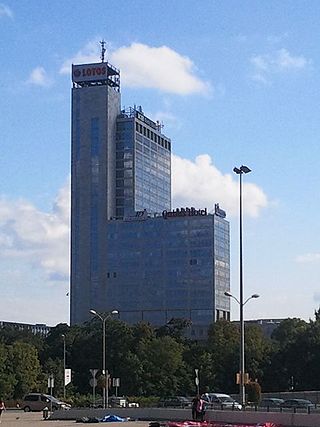
Altus is a skyscraper in Katowice, Silesia, Poland.

The Stalexport skyscrapers are twin skyscrapers located in Katowice, Silesia, Poland. The buildings share a three-story base. They were designed by Yugoslavian architect Georg Gruićić in the late 1970s and finished in 1981 and 1982, respectively.

Great Synagogue was the largest synagogue in the city of Katowice (Kattowitz), in southwestern Poland. It was erected in 1900 in what was then the German Empire, and was designed by Max Grünfeld. The synagogue was set on fire by the Nazis in early September 1939 during the invasion of Poland.

Church of St. Michael Archangel is one of the oldest buildings in Katowice. It's located in Kościuszko Park, where it was moved in 1938 from the village Syrynia, where it was originally constructed in 1510. It is under the invocation of St. Michael.

Świerklaniec is a village in Tarnowskie Góry County, in the Silesian Voivodeship of southwestern Poland. Formerly, from 1975—1998, Świerklaniec was a part of the Katowice Voivodeship.
Gmina Herby is a rural gmina (municipality) in Lubliniec County, Silesian Voivodeship, in southern Poland. Its seat is the village of Herby, which lies approximately 17 kilometres (11 mi) north-east of Lubliniec and 57 km (35 mi) north of the regional capital Katowice. Until 1993 it also included the area which now makes up Gmina Boronów.
Pustkowie Lgockie is a village in the administrative district of Gmina Koziegłowy, within Myszków County, Silesian Voivodeship, in southern Poland. It lies approximately 9 kilometres (6 mi) south-east of Koziegłowy, 6 km (4 mi) south-west of Myszków, and 39 km (24 mi) north-east of the regional capital Katowice.
Buglowiec is a settlement in the administrative district of Gmina Lubomia, within Wodzisław County, Silesian Voivodeship, in southern Poland. It lies approximately 3 kilometres (2 mi) south-east of Lubomia, 9 km (6 mi) west of Wodzisław Śląski, and 55 km (34 mi) south-west of the regional capital Katowice.

The architecture of Poland includes modern and historical monuments of architectural and historical importance.

Katowice historic railway station was the main railway station of Katowice, in the Silesia region of what is now Poland. Built in 1859 and reconstructed and expanded several times, it was judged obsolete after World War II, and in 1972 decommissioned and replaced by the newly built Katowice railway station. Three years later it was declared a National Monument. It is partially ruined and owned by a private developer who plans to renovate the station buildings and develop the complex into a multifunctional center.

Ministry of Transportation and Construction was formed on 31 October 2005, from transformation of Ministry of Infrastructure.













